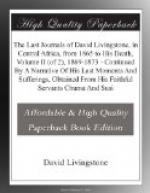26th June, 1872.—Went over to Kwikuru and engaged Mohamad bin Seyde to speak to Nkasiwa for pagazi; he wishes to go himself. The people sent by Mirambo to buy gunpowder in Ugogo came to Kitambi, he reported the matter to Nkasiwa that they had come, and gave them pombe. When Lewale heard it, he said, “Why did Kitambi not kill them; he is a partaker in Mirambo’s guilt?” A large gathering yesterday at M’futu to make an assault on the last stockade in hostility.
[A few notes in another pocket-book are placed under this date. Thus:—]
24th June, 1872.—A continuous covering of forests is a sign of a virgin country. The earlier seats of civilization are bare and treeless according to Humboldt. The civilization of the human race sets bounds to the increase of forests. It is but recently that sylvan decorations rejoice the eyes of the Northern Europeans. The old forests attest the youthfulness of our civilization. The aboriginal woods of Scotland are but recently cut down. (Hugh Miller’s Sketches, p. 7.)
Mosses often evidence the primitive state of things at the time of the Roman invasion. Roman axe like African, a narrow chisel-shaped tool, left sticking in the stumps.
The medical education has led me to a continual tendency to suspend the judgment. What a state of blessedness it would have been had I possessed the dead certainty of the homoeopathic persuasion, and as soon as I found the Lakes Bangweolo, Moero, and Kamolondo pouring out their waters down the great central valley, bellowed out, “Hurrah! Eureka!” and gone home in firm and honest belief that I had settled it, and no mistake. Instead of that I am even now not at all “cock-sure” that I have not been following down what may after all be the Congo.
25th June, 1872.—Send over to Tabora to try and buy a cow from Basakuma, or northern people, who have brought about 100 for sale. I got two oxen for a coil of brass wire and seven dotis of cloth.
FOOTNOTES:
[17] This elephant was subsequently sent by Dr. Kirk to Sir Philip Wodehouse, Governor of Bombay. When in Zanzibar it was perfectly tame. We understand it is now in the possession of Sir Solar Jung, to whom it was presented by Sir Philip Wodehouse.—Ed.
[18] Lewale appears to be the title by which the Governor of the town is called.
[19] Judges xviii.
[20] Halima followed the Doctor’s remains to Zanzibar. It does seem hard that his death leaves her long services entirely unrequited.—ED.
[21] The Portuguese name for palanquin.
[22] It will be seen that this was fully confirmed afterwards by Livingstone’s men: the fact may be of importance to future travellers.—ED.
CHAPTER VIII.
Letters arrive at last. Sore intelligence. Death of an old friend. Observations on the climate. Arab caution. Dearth of missionary enterprise. The slave trade and its horrors. Progressive barbarism. Carping benevolence. Geology of Southern Africa. The fountain sources. African elephants. A venerable piece of artillery. Livingstone on Materialism. Bin Nassib. The Baganda leave at last. Enlists a new follower.




